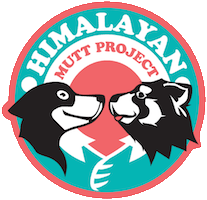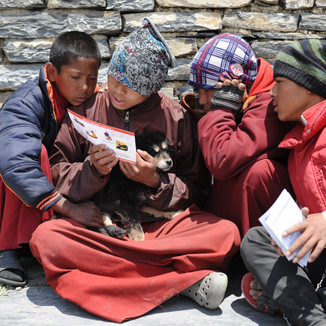Lost and Found
- Debby Ng
- Jan 30, 2019
- 4 min read

A tiny and adorable little pup accompanied these boys to our neutering and rabies vaccination camp in 2014. The boys and their dogs were from Karma Samten Ling Monastery in Ngarwal (3,900 m).
This image of the boys laughing with their dogs resting by their side has got to be one of my favourite photographs across all our years of working in the Himalaya. It captures the intimate relationship that people have with their dogs in this unique cultural landscape. This close relationship between communities and their dogs in the Himalaya means that the process of managing dogs in this conservation area will not be easy or straight forward - in many conservation areas around the world, dogs are managed by trapping or poisoning to protect native wildlife. In the Annapurna Conservation Area (ACA) however, we will have to explore alternative solutions to manage dog for the benefit of wildlife and people.
This leads us to the work that we started in 2018 with a grant from the National Geographic Society - Nepal's first canine distemper survey in the Himalaya. Distemper is a viral disease that is caused by a virus, and causes a disease that can kill a lot of wildlife very fast. We wanted to find out if distemper is in the Himalaya. If it was, it would be important for us to manage the disease quickly to be sure it does not cause an irreversible impact on endangered wildlife like snow leopards and Himalayan wolves. To learn about distemper in the Himalaya, we visited 10 villages in ACA to collect blood samples from village dogs and tested this for evidence of distemper.

In the village of Ngarwal, we found this dog (above) asleep under a table. We asked locals if he belonged to anyone. Everyone shook their head. He was a calm and quiet dog and did not let out a bark of a squirm as we pricked him to collect a small blood sample. He was given the code name "NS 30", N for "Ngarwal" and S for "stray".

After the blood collection, we went about interviewing the residents of Ngarwal to learn about their impressions and habits surrounding dogs in the village. Speaking to the keeper at Karma Samten Ling Monastry (above), we learned that four dogs live under his care, but only one was present at the monastery when we were there. Where were the others? "Wandering around," he said. We asked him to describe the four dogs. One brown, three black and tan. One of them was raised as a pup by the monks. That's when it clicked. I whipped out my phone and scrolled to photographs from April 2014. I found the photo that's at the top of this post, with the boys and the dogs. I asked him if this was one of the dogs he looked after. He excitedly exclaimed, "Yes!" and was amazed that we had this photo of NS30. "It's a big dog now!" He said. That's when it clicked. I quickly scrolled through the photos on my phone to pictures shot that very morning and showed him the photo of NS30. "Yes! This is the pup! He said with a big smile on his face. He seem tickled to learn that we had so many photos of dogs from the village! It's not evident from the photograph above, but NS30, or "Sherika" as he is named, has a very unusual bob tail that was distinct when he was a pup. I hadn't thought about it when we first photographed him as NS30, as I didn't think we'd be so lucky to as to encounter the same dog after 4 years!
Above are three photos from 2014 where you can see Sherika, as a pup, being carried by one of the boys. It's little wonder that he is such a calm and quiet dog around people, as he has been lovingly cradled and been in the close company of people since he was a tiny pup!
What do you think? Can you tell that it is the same dog? Evidence that some dogs stay in the same village after so many years shows how despite allowing the dogs to roam freely, provision of food, care and shelter can motivate dogs to stay in the same village. Sherika is a male that is not neutered, but unlike Kalo, he's not a wanderer. Why might this be? It could be because Sherika is kept as a pet dog, while Kalo is an autonomous guard dog that doesn't have much human contact. Or it could be down to behavioural differences associated with their breed. Whatever the reason, human interactions and habits, from breed selection to the role that is assigned to the dog, can influence dog behaviour with implications for dog-wildlife interactions and disease transmission. This is exciting stuff that hasn't been thoroughly explored, certainly not amongst communities in the Himalaya.
To understand how dogs need to be managed for the future, we need to know how they are being managed now. You can support our work for this community! Donate today!










































Comments